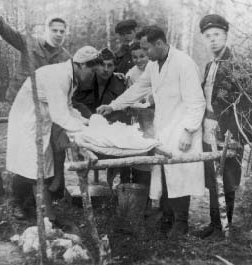“Even after 70 years, I still remember how to make my own developer,” says Faye Schulman.
During the three years she lived in the woods, fighting the Nazis with a band of Soviet partisans, Schulman documented her experiences, developing negatives under blankets at night and burying her camera and tripod in the ground when she went on missions.
Schulman’s photographs constitute the only known photographs taken by a Jewish partisan — and a woman at that.
Schulman’s photographs of the resistance movement during World War II will be on display at the University of Washington Hillel from Jan. 13 to Feb. 17. The exhibit belongs to the Jewish Partisan Educational Foundation and is being hosted by the Washington State Holocaust Education Resource Center.
In August 1942, the Polish ghetto that Schulman’s family had been confined to was raided by the Nazis, who killed 1,850 of the inhabitants, sparing only 26.
“My family was shot,” said Schulman over the phone from her home in Toronto. “And me, they didn’t want to kill, because I [could work] for the Nazis [as a photographer].”
Schulman fled into the woods to join the partisans when they attacked the town. Despite her lack of medical training, they put her to work as a nurse.
“In Russian there is a saying: if you can’t, we will teach you. If you don’t want to, we will force you,” she said. “I was afraid of wounded people, I was afraid of blood, but my life was changed…and I was a very good nurse.”
After the war, Schulman found work as a newspaper photographer in Belarus. She married Morris Schulman, another partisan, and they eventually emigrated to Toronto.
Mitch Braff, founder of the JPEF, met Schulman about five years ago and was blown away by her work. He raised the money to put up an exhibit, and they printed photographs from the negatives. The exhibit is making its way around the world: A copy is currently in Cape Town, and it is scheduled to visit 13 communities over the next year.
Braff started the JPEF, which develops educational materials for classrooms from PBS-quality films to curricula, after being inspired by a Jewish partisan’s story.
“Ten years ago I did not know what a Jewish partisan was,” he said. His goal is to give young generations the education he never had. “The idea was to do a series of about 50 interviews with partisans. These are interviews that have never been done on this scale…[with] this much detail and focus on the partisans.”
Indeed, the story of Jewish resistance against the Germans is far less told than the story of the camps and gas chambers.
“In the grand scheme of things, if you look at the number of people killed…it was such a small number [of partisans who fought] in comparison,” said Sharon Rennert, the granddaughter of partisan Tuvia Bielski. “It’s good that it’s finally coming out.”
Rennert, who will give a multimedia presentation about her family’s experience, upon which the 2008 film Defiance was based, is making her own documentary about the now-famous Bielskis.
“My personal mission is that we tell my family story in the context of the Holocaust,” she said. “I feel that it does offer another perspective. And it’s not to take away from people who couldn’t fight back.”
Rennert marvels at the fact that Hitler put a bounty on her grandfather Tuvia’s head.
“My grandfather must have been so powerful,” she said. “He posed that much of a threat to Hitler.”
For Ilana Cone Kennedy, director of education for the Holocaust Center, telling the partisans’ story is more than another perspective. It’s a potential paradigm shift. Studying the 30,000 Jewish boys and girls who fought the Nazis “affects the way we think about Judaism and Jewish people and our own history,” she said. “I think there’s so much in Judaism that’s so powerful and so wonderful that we want to get a hold of, but Judaism often looks at our past as victims throughout history, and it’s wonderful to see Jews throughout the world really fighting.”
A conversation with one of the Holocaust’s co-directors about seeing the Holocaust through lens of partisans instead of through victims led to the shift.
“This notion of people just being rounded up passively is so false, even when you look at those situations,” Kennedy said. “There were groups that were actively resisting, beyond the Warsaw Ghetto uprising.”
Braff hopes the exhibit will impart a threefold lesson to future generations: One, he said, that young people can make a difference. Two, that people must stand up to tyranny and oppression, and three, that people should question authority.
“I think it’s important for the young Jewish generation to know that Jews are not cowards,” Schulman said. “Children should be proud to be Jewish, not ashamed. It’s something to be proud of.”
Of all the photographs Schulman took, the one that stands out the most was not her own. In the aftermath of the obliteration of her ghetto, she developed the photograph of her entire family in a mass grave.
“They took the pictures of the killing and they brought me the film to develop,” she said. “I developed and I noticed: This is my family. So I made a copy and I hid it. This is the most important picture for me.
“So many years have passed,” she said tearfully, “but for me, it’s like yesterday.”
The Holocaust through a different lens
